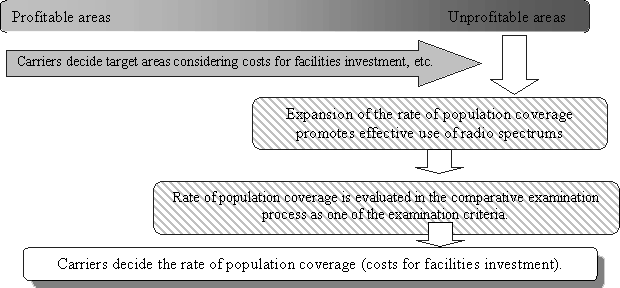| |
Paragraph 1. Procedures for developing radio spectrum reallocation
plan
| (1) |
Upon development of a radio spectrum reallocation plan, adequately
considering expectations of the incumbent licensees for continuous
use of radio spectrums, deliberations shall be made so as to take
prompt actions in order to meet a new demand for radio spectrums.
In this case, procedures for developing the reallocation plan are
to be considered so that transparency and fairness can be sufficiently
ensured in the course of the development thereof.
|
| (2) |
As regards this point, in line with the revision in 2002 of the
Radio Law, a legal scheme was introduced (effective from October
31, 2002) for contributing to development of the radio spectrum
reallocation plan under which the Minister for MPHPT i) conducts
survey, etc. of actual radio spectrum usage, ii) publicizes the
results thereof, iii) invites public opinions on them, and iv) assesses
to what degree radio spectrums are being used effectively.
Upon the development of the reallocation plan, the Minister for
MPHPT shall i) sufficiently utilize the newly introduced scheme
for conducting survey, etc. of actual radio spectrum usage and publicizing
the results thereof, ii) at the same time, clearly show objective
criteria concerning appropriateness for implementing the reallocation
and methods for implementation, then, iii) take into consideration
public comments, etc.
|
Paragraph 2. Short-term reallocation
| (1) |
Under the Radio Law, the valid term of licenses for radio stations
is in principle within five years considering necessities for i)
reviewing radio spectrum allocation on a regular basis along with
changes in socioeconomic activities and development of science and
technology, and ii) protecting the status of licensees for stably
using radio spectrums. In principle, licenses may not be revoked
within the valid term. In cases where the Minister for MPHPT requires
licensees to terminate the use of radio spectrums within five years
after setting forth the reallocation plan (short-term reallocation),
the relationship between the valid term of licenses and the reallocation
plan becomes a problem because some licensees are to terminate the
use of radio spectrums within the valid term of licenses in question.
|
| (2) |
It is essential to consider the fact that the significance of
radio spectrums in socioeconomic activities, etc. has been growing
much bigger in recent years. In cases where public interest which
is high require new radio spectrums to meet demand for wireless
access, mobile communications, etc., a new scheme shall be developed
for enabling short-term reallocation.
|
| (3) |
Upon introduction/operation of the new scheme, it is vital to
comprehensively assess the public interest needs, taking into account
appropriate consideration to various conditions of licensees, such
as availability of alternative communications means. Furthermore,
with regard to ensuring of consistency between the legal nature
of the valid term of licenses, deliberations henceforth shall be
delved into from the legal viewpoint.
|
Paragraph 3. Whether to compensate the incumbent licensees or not
| (1) |
For instance, when implementing the short-term reallocation, as
target incumbent licensees are to terminate the use of already-assigned
radio spectrums after the elapsing of a comparatively short term
since the development of the allocation plan, the incumbent licensees
cannot use radio facilities compliant with said radio spectrums
and have to shoulder costs for procuring alternative facilities.
|
| (2) |
Radio frequencies are public resources. Thus, licensees are temporarily
granted a status that allowed use of radio spectrums. Taking these
into consideration, compensations for covering the right to use
radio spectrums and purchase costs of alternative facilities, that,
as a result, become assets of the licensees, are thought to be unnecessary.
|
| (3) |
In reality, however, licensees are investing in radio facilities
and installation thereof on the assumption that the use of radio
spectrums is allowed to continue to some degree. Measures shall
be considered for preventing substantial losses on licensees, such
as a subsidization scheme under which the government compensates
a portion of investment (remaining book value of facilities, etc.),
which cannot be recovered by implementation of the reallocation.
|
Paragraph 4. Others
| (1) |
From now on, as regards frequency bands used by radio stations
requiring no licenses, it is foreseeable that deliberations shall
be made on implementation of prompt reallocation. In this case,
as the Minister for MPHPT has no means to know the whereabouts,
etc. of radio stations requiring no licenses, it becomes difficult
to ensure effectiveness of the reallocation plan, such as publication,
etc. of the implementation of the reallocation plan.
|
| (2) |
Meanwhile, from the viewpoint of promoting development of radio
LANs, ICT consumer electronics, etc., convenience of radio spectrum
users brought about procedures requiring no licenses shall be taken
into consideration.
|
| (3) |
Accordingly, taking into account concrete usage modes of radio
spectrums, it is an important task to develop desirable measures
for both ensuring effectiveness of prompt reallocation and improving
convenience of radio spectrum users.
|
| (4) |
In addition, upon reallocation of radio spectrums, considering
that status of the shortage of assignable radio spectrums varies
in different areas, such as rural or urban areas, measures for the
reallocation shall be geared to the realities of each local area.
|
| (5) |
As regards this point, in line with the revision in 2002 of the
Radio Law, a legal scheme was introduced for conducting survey,
etc. of actual radio spectrum usage and publicizing the results
thereof. Thus, taking into consideration the area-by-area results
of the survey, after ensuring technological possibilities for sharing
frequencies with other radio stations, the administration shall
reallocate frequencies in accordance with the realities of each
local area, so as to promote effective use of radio spectrums.
|
|
